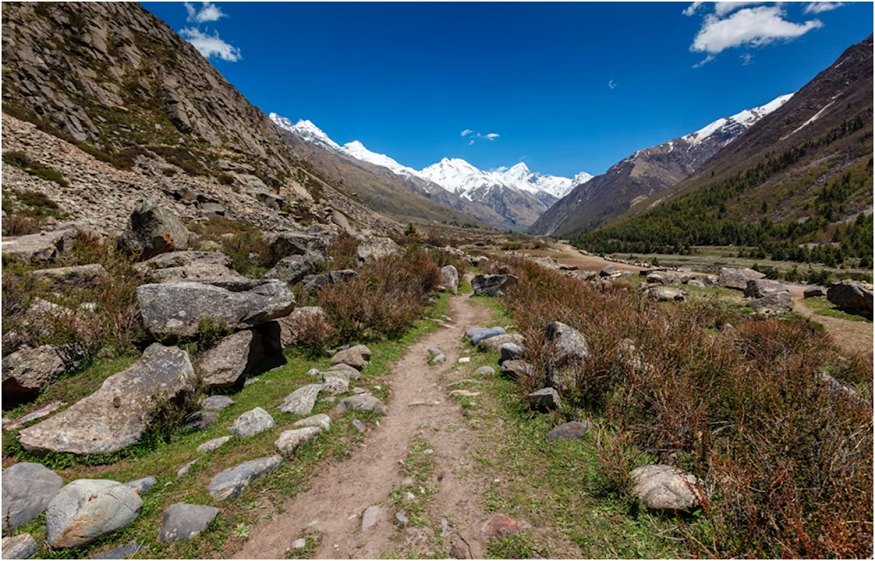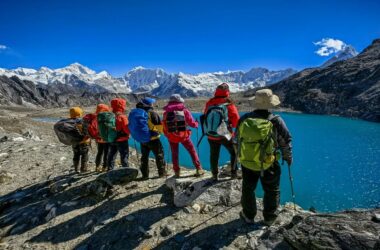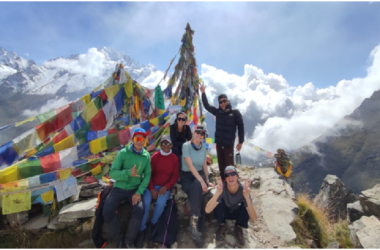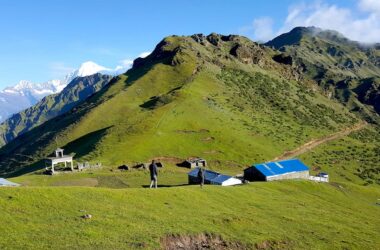Nepal is a land of high mountains, deep valleys, old culture, and a strong trekking dream. In this big adventure, we talk about four wild and hidden treks—Nar Phu Valley Trek, Annapurna Circuit Trek with Tilicho Lake, Manaslu Circuit Trek 10-Days, and Makalu Base Camp Trek. All these trails are not so touristic like Everest, but they have a more raw, wild, beautiful, and true feeling of the Himalaya. This article gives you a full story of these treks with details—route, best time, food, stay, tips, and more.
Nar Phu Valley Trek
The Nar Phu Valley Trek is very off the track, inside the Annapurna region but feels totally different. It is near the Manang area, but the path goes into a hidden valley where only a few people live. Two villages—Nar and Phu—are full of Tibetan culture, old stone houses, prayer flags, and high cliffs.
Routes and Highlights:
The trek starts from Koto, near Chame. Then the path enters into a narrow gorge and forest, passes a waterfall, and then reaches Phu village. It is old, like time stops there. You can also go up to Himlung base camp if you want. Then return back and go to Nar village, another amazing place. Cross Kang La Pass (5320 m) to join back to the Annapurna trail. This pass gives a crazy view of Annapurna II and Gangapurna.
Why choose this trek:
This trek is wild, remote, and has few people. You see real culture and walk through untouched land. It is perfect for those who want a peaceful trek, far from the crowd. Also good for photography, exploring, and learning old ways of life.
Annapurna Circuit Trek with Tilicho Lake
This is an old and very famous Annapurna Circuit Trek with Tilicho Lake becoming more special. The Annapurna Circuit with Tilicho mixes everything—river, forest, mountain, high pass, and holy lake.
Routes and Highlights:
Start from Besisahar and walk through lowland villages like Jagat and Dharapani. Slowly go up to Chame, Pisang, and Manang. From here, take a route to Tilicho Lake—one of the highest lakes in the world. After Tilicho, return to Yak Kharka and go up to Thorong La Pass (5416 m), which is very windy and cold but amazing. After passing, go down to Muktinath, then Jomsom.
Why choose this trek:
Tilicho Lake adds a bonus in the classic Annapurna trek. It is blue, silent, and pure. The full trek shows all geography—green forest to high desert. Annapurna, Dhaulagiri, Nilgiri, and many other mountains are always around. Also many local villages have different cultures, like Gurung and Thakali.
Manaslu Circuit Trek – 10 Days
The Manaslu Circuit Trek is fast becoming a top trek for those who want a wild feel like Annapurna used to have. It goes around Mt. Manaslu—the 8th highest peak.
Routes and Highlights:
The trek starts from Machha Khola or Soti Khola. Go through villages like Jagat, Deng, Namrung, and Samagaon. The big view comes after Namrung. You see Manaslu close to Samagaon. Also go to the Manaslu base camp side trip or Pungyen monastery. Then reach Samdo and Dharmasala. Cross Larke La Pass (5106 m) and come down to Bhimtang, then Dharapani.
Why choose this trek:
Manaslu is still less busy than Annapurna and Everest. It has raw mountains, Tibetan culture, and simple life. The views of Manaslu, Ganesh Himal, and glaciers are very big. The 10-day version is good for strong trekkers who want a compact but full trek.
Makalu Base Camp Trek
This Makalu Base Camp Trek is for serious adventurers. Makalu is the fifth highest mountain, and its base camp trek goes into Barun Valley, which is pure and untouched.
Routes and Highlights:
Start from Tumlingtar or Num. The trail goes up and down many times—through forest, across rivers, and past Sherpa villages. Go to Seduwa, Tashigaon, and then enter the wild zone. Cross two high passes—Khongma La (3870 m) and Shipton La (4229 m). After that, we reached Makalu Base Camp (4870 m), full of glaciers, ice walls, and giant peaks. The view of Makalu, Everest, Lhotse, and Baruntse is unforgettable.
Why choose this trek:
The Makalu region is not touristic and is very silent. You walk through a real jungle, a big rhododendron forest, and see animals like red pandas and mountain goats. It is a national park area, protected. The trek is difficult, but the reward is 100%. You feel alone in big mountains.
Why Choose These Treks?
These treks are not for everyone. But for those who want real experience, these four treks are perfect. Nar Phu and Manaslu show deep Tibetan culture and not many people. Tilicho and Annapurna show mountains, lakes, and a mix of cultures. Makalu is pure wild. No crowd, no noise, just foot on trail and wind in hair. These treks are for heart travelers, not tourists.
Routes and Highlights Overview
| Trek Name | Major Points | Max Altitude | Key Attraction |
| Nar Phu Valley | Koto, Phu, Nar, Kang La Pass | 5320m | Hidden Tibetan villages, offbeat trail |
| Annapurna + Tilicho | Besisahar, Manang, Tilicho, Thorong La | 5416m | Blue lake, high pass, culture |
| Manaslu 10-Day | Machha Khola, Samagaon, Larke Pass | 5106m | Raw mountain, peaceful villages |
| Makalu BC | Num, Tashigaon, Shipton La, Base Camp | 4870m | Deep forest, glacier, Everest view |
Best Time to Go
- Spring (March to May): Best season. Flowers bloom, and the sky is mostly clear. Rhododendrons everywhere, good light for photos.
- Autumn (September to November): Clean sky, dry path. A big view of the mountain every day.
- Winter (December to February): Not good for passing. Cold and risky.
- Summer (June to August): Too much rain, leeches, slippery.
Makalu and Nar Phu are better in autumn. Manaslu and Tilicho are okay in spring too.
Food and Accommodation
These treks are remote, so food and stay are basic. But still you get warm food and a bed.
- Food: Dal bhat is always available. Also noodles, potatoes, pancakes, soup, tea, and coffee. In a big village, maybe momo and pasta.
- Accommodation: Mostly teahouses. Small room with twin bed. The toilet can be inside or outside. Blanket given, but carry your own sleeping bag.
In Makalu, after Tashigaon, the stay is very basic. You may need a tent or sleep in a porter hut. Carry extra snacks and fuel.
Weather and Temperatures
- Spring (Mar-May): Warm days (15–20°C at lower parts), cold nights (0–5°C), snow in passes.
- Autumn (Sep-Nov): Cool days (10–18°C), cold at high places (-5°C night). Best clear weather.
- Winter (Dec-Feb): Very cold (-10°C at high camp), snow block trails, few trekkers.
- Monsoon (Jun-Aug): Hot and wet, slippery trails, risk of landslide.
Always carry warm clothes, a down jacket, sleeping bag -10°C rating, rainproof jacket, gloves, hat, sunglasses, sunscreen. Layering system best for changing conditions.
Tips for First-Time Trekkers
- Train Before: These treks need strong legs and lungs. Walk and hike at home before coming.
- Pack Right: Warm jacket, raincoat, good shoes, hat, gloves, water bottle, headlamp, and basic medicine.
- Slow and Steady: Don’t rush. Altitude can make you sick. Drink lots of water, eat well, and rest if tired.
- Respect Culture: Say “Namaste,” don’t shout, and dress modestly in the village. Ask before a photo.
- Cash Only: No ATM in the mountains. Carry Nepali rupees from Kathmandu.
- Permit Ready: All these treks need a special permit. Take help from an agency or guide.
- Guide and Porter: It’s a good idea to hire a guide. They help in route, culture, and emergency. Porter carries a bag and helps you enjoy trekking.
Conclusion
Nar Phu, Tilicho, Annapurna Circuit, Manaslu, and Makalu Base Camp—all these are not just treks. They journey into the heart of the mountain and the soul of culture. You don’t just walk; you feel. You see mountains, yes—but also learn peace, slow life, and strength inside you. These treks may not have fancy hotels or coffee shops, but they give big gifts—adventure, silence, beauty, and memories forever.
So if you dream to go away from normal, to walk the path not many people go, to see nature raw and culture real, then this is your ultimate wild trek. Pack your bag, tie your boots, and let the mountain guide you. The Himalaya is calling—are you ready to listen?




